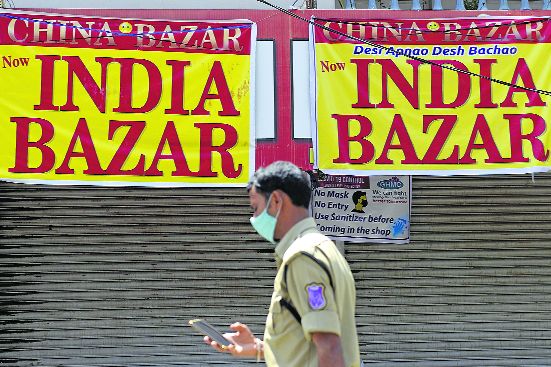
SOURCE: The Tribune
The trying times have been made gloomier by a recent report that despite “boycott-China calls, three in every four smartphones sold in India are Chinese.” This by itself indicates why, through the ages, people and rulers of India failed to protect their self-interest and territory from foreign invaders, and lost out on commerce and political sovereignty on their own land.
Regrettably, the 21st century appears to be no different from the past: “The smartphone segment in India rebounded after the lockdown to touch an all-time high of 50 million units in September 2020”, a quarter of which is with Chinese companies, collectively holding 76% of the market share, and not with any Indian company, despite the calls for Make in India and Atmanirbharta.
Understandably, therefore, the present scenario constitutes a classic case of (reversed) mirror reflection in which affluent Indians are found to be irreversibly addicted to Beijing-made consumer goods, the way the Chinese were once addicted to India-produced opium in the 19th century, distributed by the hereditary trading class and middlemen, and transported and sold in Chinese ports by the East India Company, thereby damaging the economy and health of the Hans for over 75 years.
Let us, therefore, make rough calculations of the minimum expenditure Indians must have had incurred on these ‘addictive’ foreign goods, auto-generating profit for the Dragon. What’s the loss? Assuming an average price of Rs 10,000 per unit, the expenditure on 5 crore Chinese smartphones would come to a whopping Rs 50,000 crore or $7 billion approximately. It’s the figure for the quarter ending September 2020.
How obnoxiously humiliating the Indian position could be? The question is: Is the smartphone an ‘essential commodity’ without which India will be stuck in the Stone Age? Should India take lessons in fiscal prudence and strategic economic planning to take the nation forward, not being perennially tied up to deficit, and chronically escalating trade deficit? Especially, owing to an explicitly hostile country damaging on all fronts, internal and external?
China’s path to success was dictated by the state, and not by profiteering private mercantile trading class or the state enterprises handed over to private players through the disinvestment mantra. Beijing rose through mercantilism operated by the state. Little wonder, when the chronic foreign trade deficit in the mid-1980s was resulting in the loss of China’s ‘self-reliance’, like the India of the 21st century, a ‘consumer goods spending spree’ in 1984 caused the government to ‘lose control over imports’. The trade deficit of China skyrocketed.
China, however, overcame the hurdles through deft currency manipulation and by striking an import-export balance, cutting non-essential import, accelerating manufacturing and seeking foreign markets. By 1990, China achieved trade surplus, which shot up, irritating the West, yet turning it into demand for mass-produced, cheap consumer goods by the same foreigners.
The game Beijing played on the West was either missed or misread by India’s ever increasing consumers who got hooked to cheap foreign goods, irrespective of its quality. China got the market knob. India lost the appetite for competitively priced manufactured goods. To top it all, India (and the world) was gripped by the Chinese virus.
Little wonder India is taking cover to survive the multi-pronged Chinese assault, from brazen territorial occupation to the Chinese-virus pandemic. Economics, trade, commerce, banking, finance, industry, telecommunication, espionage, hinterland crime, luring and letting down top Indian entrepreneurs and naval penetration in the guise of fishing, making a nation look disjointed and distraught — too many trouble spots forcibly created by the Communist Party of China (CPC).
Thus, the overall situation for India looks grim in the face of Han belligerence. Consequently, Delhi had no option but to make the unprecedented gesture of expanding the 2+2 diplomacy into the India-US defence pact in October, somewhat akin to the India-USSR defence agreement on the eve of the 1971 India-Pakistan war, which changed the geography of South Asia.
Expectedly, however, the expanded India-US pact hasn’t gone down well as China considers the physical advent of Washington in South Asia as a disruption of its monopoly in profit, diplomatic one-upmanship and ceaseless military bullying of Beijing in the India-China bilateral. In one stroke, the US comes too close to China’s BRIC, CPEC, OBOR and the so-called Silk Route down the vast Central Asian landscape.
Contextually, what is, however, noticeable is a drastic change in China’s tenor. Is it a glimpse of Mao’s military writing? Two steps forward (against India in the Himalayas) and one step backward (at the sight of Americans on Indian soil for military/defence pact)?
Else, how does one explain a mellowed China’s emphatic plea — the boundary question is a bilateral matter, the border situation is stable, there is no room for US intervention. Surely, it’s ‘stable’, after India losing its soldiers, and the forcible occupation of 1,000 square km of territory within the LAC. With no chances of a status quo ante, the CPC’s stand on India continues to be nasty.
The reality is, China understands power, military or monetary, preferably, both. Monetarily, India is a lucrative market for the Han communists. Hence, they hate to leave Hindustan, as it gives them an upper hand to mess with India on the border and gobble up territory, a feature which is in the DNA of the CPC. It simply cannot exist without expansion.
Can India halt the CPC juggernaut? Can the Indians hope for that time to arrive?






